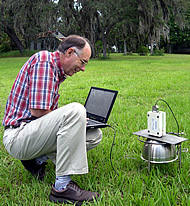This page has been archived and is being provided for reference purposes only. The page is no longer being updated, and therefore, links on the page may be invalid.
|
|
USDA's Florida Research Station Celebrates 75 Years of Excellence
By Alfredo FloresMay 25, 2007
BROOKSVILLE, Fla., May 25—The Subtropical Agricultural Research Station in Brooksville, Fla., operated by USDA's Agricultural Research Service (ARS), today celebrated 75 years of research accomplishments. The Brooksville station has served as the national center for characterization, evaluation and preservation of tropically adapted beef cattle germplasm.
"Scientists here have advanced the genetics, physiology and nutrition of beef cattle, as well as forage production and water quality," said Ronnie D. Green, ARS' national program leader for food animal production.
Among the scientists' accomplishments are the creation of a three-breed cross of Angus, Brahman and Romosinuano cattle; the use of DNA to screen beef cattle populations for better breeding; identification of gene markers responsible for slick or longer hair coats in Senepol cattle and their crossbreeds; and screening bahiagrass for cold tolerance and quality.
The Brooksville station's study pertaining to water quality in lakes showed that properly managed cow-calf operations should not be major contributors to excess loads of phosphorus in surface water. Readings over a 15-year period, from 1988-2002, revealed a declining trend for all levels of phosphorus and other crop nutrients in lake waters, relieving concerns in west central Florida about runoff from nearby cow pastures.
Another recent project at the station concluded the perennial peanut (Arachis glabrata) adapts well to the upland soils and climate of the coastal plain, where it improves the quality of pastures and hay in subtropical U.S. areas.
The Brooksville station began in 1932 with 2,100 acres of rolling timber and pastureland donated to the federal government by Col. Raymond Robins. Today it has 20 full-time federal and state employees. It covers about 3,800 acres, with nearly 85 percent of that land in permanent pasture to support approximately 500 head of breeding cows in a herd of 1,000 cows, bulls and calves.
The facility is operated by ARS in cooperation with the University of Florida's Institute of Food and Agricultural Sciences. ARS is the chief intramural scientific research agency of USDA.

